Contents
The variety of apricot varieties available on the horticultural market is often confusing. How to choose a suitable seedling that will grow and not require complicated personal care is the main question that worries an inexperienced summer resident. One of the best unpretentious varieties is the Countess apricot, which grows well in regions with a warm climate.
History of breeding
The apricot variety Countess is a collection species that was bred in the Botanical Garden of Moscow State University. Professor A.K. Skvortsov under the guidance of Candidate of Biological Sciences L.A. Kramarenko isolated this type of fruit tree in 1988. A variety of apricot varieties was intended for cultivation in the Moscow region. The apricot Countess was entered into the State Register for the Central Region in 2004.
Description of the culture
Apricot Countess grows quite tall and vigorous tree with a rounded crown. Its height reaches 5,5-6 m. The foliage is quite large. The flowering period comes a few days later than other varieties. Numerous inflorescences do not exceed 2,5 cm. Each of the leaf axils is endowed with many generative-type buds. The stamens are underdeveloped. Anthers painted in white shades do not form normal pollen. A fruit tree is pollinated with the help of pollen from other varieties. The yield of the variety is at a high level.
Ripe fruits are round or oval. The variety is quite capricious and sensitive to changing weather conditions. In cases where the summer turned out to be hot and dry, the fruits grow clean and beautiful. Their weight reaches 25 g. With average yields, the fruits increase in size up to 40 g. The bright orange, dense and very juicy pulp is covered with a thin skin, which is painted in cream or pale yellow tones. A kind of blush can be seen on all fruits. According to the data on the chemical composition of the apricot, the fruit consists of:
- dry matter – 13,8%;
- Sahara – at 7,7%;
- titratable acid – 1,8%.
For every 100 g of fruit weight, there are 660 mg of potassium. The stone of the Countess grows to a large size (11,5%), but it is not difficult to separate it from the pulp.
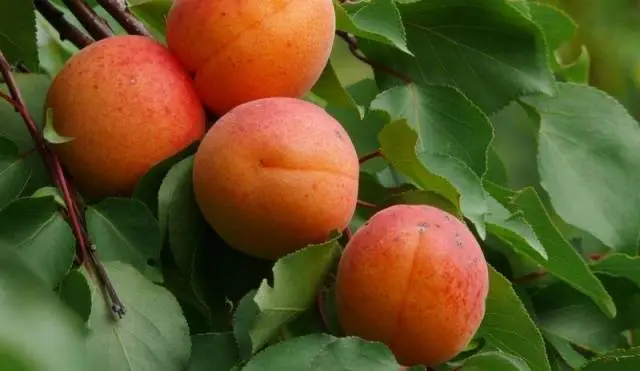
Growing apricot Countess is possible in the Moscow region and other cities with a warm climate. Reviews about the Countess apricot in the Moscow region confirm the high level of productivity in the region and the timely ripening of the fruit.
Characteristics of the apricot variety Countess
Drought resistance, winter hardiness varieties
The frost resistance of the tree is excellent. Apricot is able to withstand frosts down to -25, 30 ° C. However, during the flowering period, the buds will not tolerate the return of severe frost.
The fruit tree does not need abundant watering, so it tolerates long periods of drought well.
Pollination, flowering period and ripening period
The Countess is growing fast enough. The height of the tree in some cases can even exceed 6 m. Given the fact that the variety is not able to self-pollinate, trees of other varieties should be planted next to the apricot.
The variety needs pollinators located nearby. The best pollinators for apricot Countess:
- Lel;
- Triumph northern;
- Favorite;
- Monastic.
The flowering period of the variety comes a few days later than an ordinary apricot. You can enjoy the first fruits already closer to August 10-15. Full ripening of the crop continues until the end of summer.
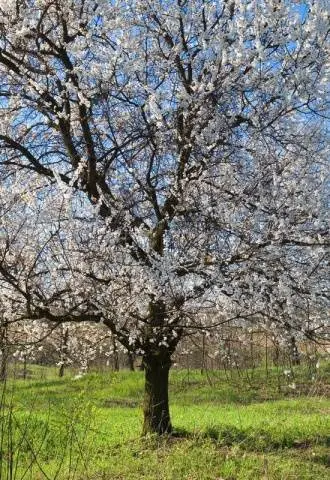
yield, fruiting
The harvest of the Countess variety is generous, it is 25-30 kg per tree. Each of the branches of the fruit tree is literally dotted with large fruits.
Scope of fruits
A high-yielding apricot variety is canned and frozen. Fans of strong drinks make apricot liqueur at home.
Disease and pest resistance
Resistance to diseases and pests depends on weather conditions. If the summer turned out to be dry and hot, then the fruits will be large and clean. In rainy, cool summers, the tree is susceptible to clasterosporia. The disease spoils the appearance of the crop. Black spots appear on the skin, which can be either small or cover a significant part of the surface of the fruit. Sometimes severe gum disease occurs.
Advantages and disadvantages
Advantages of apricot variety Countess:
- large fruit size;
- early and long period of fruiting;
- high level of resistance to various pests and diseases;
- excellent winter hardiness of the variety;
- good transportable qualities;
- abundant fruiting.
It is also worth highlighting the high tasting score of the variety.
Among the shortcomings worth noting:
- change in taste characteristics depending on the weather;
- reduction in fruit size with an abundance of crops;
- susceptibility to infection with clasterosporiasis and the occurrence of gum disease during a prolonged rainy period.
Features of planting varieties
Planting and caring for an apricot Countess does not require special knowledge and skills. Even a novice gardener can grow it.
Choosing the right place
The most important thing is to choose the right place before planting, since the Countess apricot variety will not bear fruit and bloom if it is constantly in the shade and there is no nearby pollinator tree. The site that was chosen for planting should be dry, well lit and ventilated.
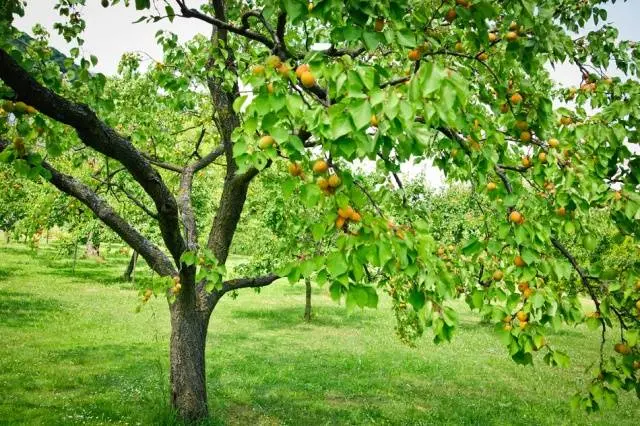
Selection and preparation of planting material
An annual or biennial tree that is over 50 cm tall is best suited as planting material. The roots of a high-yielding variety seedling should be strong, healthy and show no signs of wilting or obvious damage by diseases and pests. It is important that the grafted part of the plant is mature and strong enough. The bark of the seedling of the variety should be painted in brown tones.
Recommended dates
It is recommended to plant a seedling of a high-yielding variety in the spring, when the buds have not yet blossomed. A hole is dug in a pre-selected place and filled with a nutrient mixture:
- 2 kg of rotted compost;
- 35 g superphosphate;
- 25 g of potassium salt;
- 15 g wood ash.
The mixture is thoroughly mixed with the soil. The seedling must be watered abundantly, mulched and cut off the top so that the height of the tree is 60-65 cm.
Landing algorithm
Before planting an apricot, you should inspect its root system. If there are damages on it, it is recommended to cut them off. Then a mash is prepared on the basis of mullein, water and earth and the root is dipped in it.
- A pit is prepared, the size of which is 50x50x50 cm.
- On the surface of the bottom of the pit, a tubercle is formed from the earth. In this place, a peg is driven in for support.
- The apricot is lowered into the hole in such a way that the root neck is located 5-6 cm above the ground level.
- The root system is covered with the top layer of soil and the area around the apricot is rammed.
- A hole is formed around the circumference of the fruit tree, the diameter of which should be 60-70 cm.
- With the help of a rope, a tree is tied to a peg.
- Watered with 25 liters of water, a seedling of a high-yielding variety. Then the hole is mulched with wood shavings.
- If necessary, cut the seedling so that its height does not exceed 65 cm.
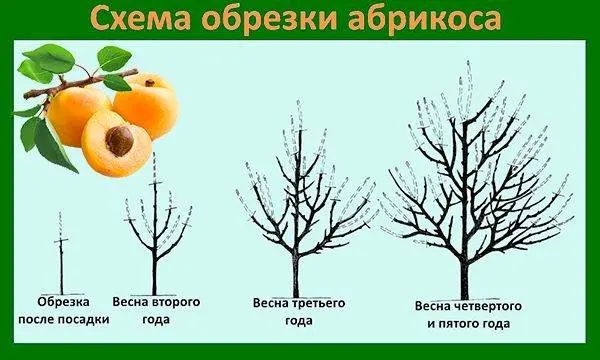
If you deepen the root neck into the hole, then the growth of the plant will begin to be inhibited.
Culture aftercare
After planting, the Countess apricot variety requires systematic care:
- It is important to carry out annual pruning in the last days of March. Problematic apricot branches must be removed, and the number of healthy shoots must be regulated.
- To form the crown of a tree, choosing a sparse-tiered form.
- Water abundantly, especially during periods of flowering, growth of new shoots and a couple of weeks before harvest. It is recommended to moisten the soil in the region of the near-stem circle by 25-35 cm. In the autumn, it is best to pour the tree abundantly so that the water penetrates to a depth of more than 0,5 m.
- Timely fertilize in order to provide yourself with a high yield and large fruits. The first time after planting a seedling, it must be fertilized after 2 years. To make fertilizer, you will need to mix 40% potassium salt, 5 kg of rotted manure and 60% nitrogen compound. You can also purchase a complex preparation for feeding, which contains iron, boron, manganese.
- Before the onset of the first frost, it is important to cover the tree with a wooden cone, which is wrapped in a strong cloth, and sprinkle it with soil. Carrying out these activities will allow the young tree to avoid freezing.
Collection, processing and storage of the Countess crop
The fruit tree begins to bear fruit 3 years after planting in mid-August. In the first years of fruiting, 20-25 kg of crops are removed, and an adult tree brings more than 60 kg of fruit annually. It is necessary to harvest in stages, since the ripening of stone fruits is not simultaneous. If you send the harvest in a wooden box in a room where the temperature is kept at 0 ° C, you can save both appearance and taste for 30-50 days. Fruit can also be dried and frozen.
Countess apricot can be eaten fresh or used to prepare:
- compote;
- jam;
- preserves;
- jam;
- marmalade;
- alcoholic beverages;
- confectionery fillings.
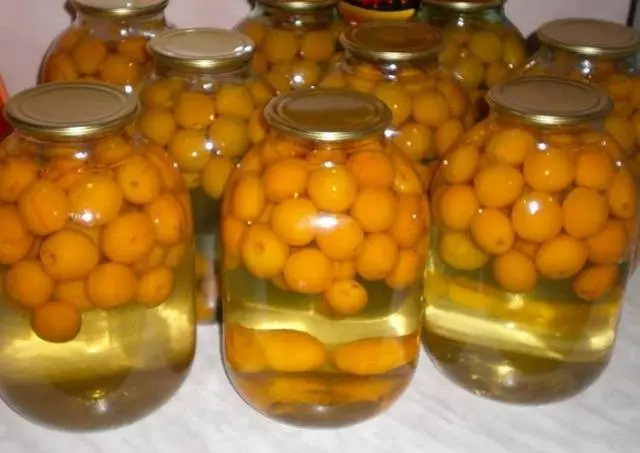
Diseases and pests, methods of control and prevention
Diseases | The nature of the defeat of the variety | Methods of struggle |
Moniliasis | Fungal infection quickly affecting foliage, inflorescences and buds. The affected branch and inflorescences soon become brown and dry. Affected fruits fall off, and those that remain on the branch become a source of infection next year. | In the case when there are suspicions of infection with moniliosis, the affected area should be immediately cut off and the cut should be treated with a garden pitch. In autumn, it is recommended to whiten the apricot trunk and spray the tree with Bordeaux liquid. |
Cytosporosis | A fungal infection affecting part of a tree. When an illness occurs, the foliage turns brown and dries. The affected bark of the tree becomes yellowish. | To solve the problem of cytosporosis, experts advise regularly whitewashing the trunks, plowing deeply and removing root shoots, cutting down and burning the affected areas of the tree, and mulching the soil around the trunk. |
Klyasterosporiosis | When perforated spotting occurs, branches, foliage and fruits are affected. Spotting of a rounded shape of a light brown shade is formed throughout the foliage. Wart-like brown swellings form on affected fruits. Gum subsequently begins to flow from them. | It is very important to cut and burn the affected area in a timely manner. The cut is processed with a mixture of garden pitch and iron sulfate. In the autumn, the trunks should be whitewashed. Trees should be treated with fungicides for preventive purposes. |
|
|
|
Pest | Methods of struggle |
Aphid that affects the foliage of the variety. Insects feed on the nutrients of the greens, which causes them to curl and dry out. | To combat insects, it is necessary to treat the tree with 150 g of tar soap, diluted in 10 liters of water. Affected areas are trimmed and burned to avoid further spread of aphids on the tree. |
Hawthorn caterpillar, gnawing buds, buds and inflorescences of a fruit tree. | It is very important to periodically inspect the apricot and destroy the caterpillars. Any cobwebs should be removed from the branches so as not to create ideal conditions for laying pest eggs. We spray the Countess with a solution of Chlorophos in spring and autumn. |
Conclusion
Growing apricot Countess, it is important to periodically inspect the trees and take the necessary measures to prevent the development of diseases. In addition, the planted fruit tree should be looked after and fertilized systematically.
Reviews
Reviews of the Countess apricot can be found on many gardening sites. Gardeners speak remarkably about this variety and recommend it to other summer residents for planting.









